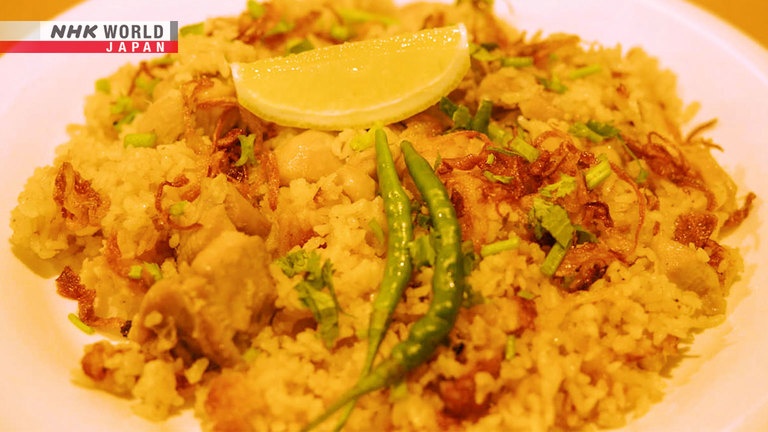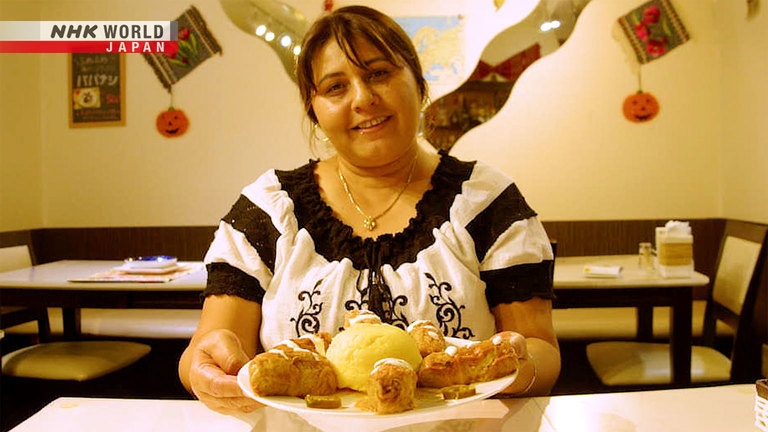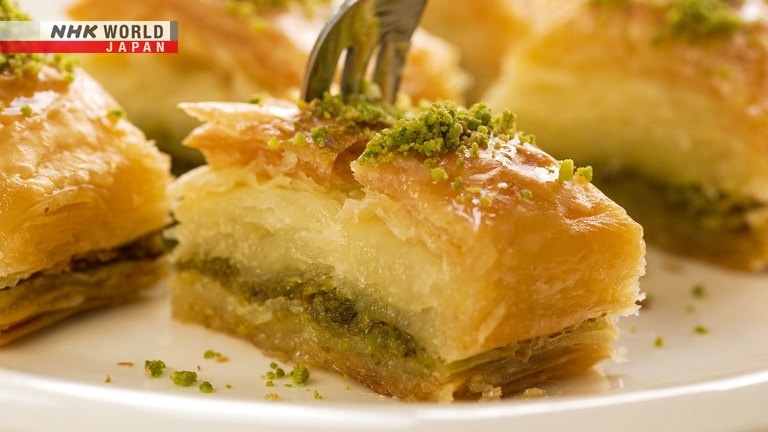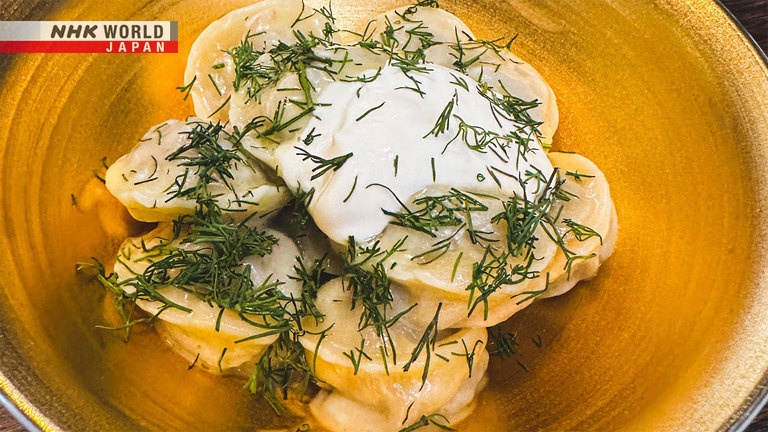A World of Home Flavors in Saitama
On this episode, we take you on a culinary tour of Saitama Prefecture's diverse international community as we meet non-Japanese restaurant owners who serve dishes from their homelands to both warm the hearts of their compatriots and delight the locals. We visit Bless from Cameroon who cooks some of her hearty banga soup in Kasukabe, Cypriot Hasan who prepares sweet baklavas in Sayama, Ukrainian-born Lyuda who whips up a batch of her savory pelmeni dumplings in Kawaguchi as well as a few others!




Transcript
Where We Call Home.
Located just north of Tokyo, Saitama is a convenient and comfortable place to live in,
which is perhaps partly why it's home to many foreigners who moved to Japan.
Throughout the prefecture, we find restaurants serving food from their native countries to fill both stomachs and hearts.
This is banga soup, a hearty dish from Cameroon.
Vegetables and chicken simmered in a fish broth.
A taste that puts a spring in your step!
Here is a traditional Turkish dessert: baklava.
Hoping the sweet treats will help introduce his homeland of Cyprus is this company owner.
A great batch today!
These are Ukrainian-style pelmeni.
For those who fled the war raging in their home country, it's a heartwarming taste that brings people together.
Join us on a tour to discover home cooking from around the world in Saitama.
We begin with the city of Kasukabe.
The setting for a popular animated series, it's a town known for being an excellent environment to raise children.
About a ten-minute train ride from the city center is a restaurant that bustles with hungry Cameroonians on weekends.
Welcome! Welcome!
Bless opened her shop in 2018.
Many of her compatriots with jobs in industries like construction live in and around Kasukabe.
To reinvigorate them after a hard day of work, Bless knows just what to serve them.
This is banga soup!
Bon appétit!
Banga soup is a kind of curry many Cameroonians have grown up eating at home.
A base of fish broth and palm nuts in which chicken and vegetables are slowly simmered,
it makes for a very nourishing meal.
Born in Cameroon, Bless wanted to one day work in Japan.
In 2008, she made the big move with the dream of opening a restaurant that offered dishes from her native country.
My mother back then in Cameroon, my mother owned a restaurant for twenty-five years.
So, since I was small, I'm used to cook with my mother, and I love cooking.
My mother's banga soup is the best, because there in Africa, in Cameroon in particular...
So, I decided to open my own restaurant.
Bless is going to show us how she makes banga soup.
This is banga base.
The base is a paste of palm nuts and oil.
She mixes in some hot water, then simmers it in a pot.
Cameroon curry...
I do want to feel home.
All around... feel home.
Wait some... Coming!
She changed into a traditional outfit - the better to put her in the mood for cooking Cameroonian style.
Banga soup is very known.
I'd like to put that catfish. This is catfish.
She uses dried catfish to enhance the broth.
It is a bit oily. It gives the flavor in the curry. It's just too much.
So, while it's boiling, I put it inside.
She then adds a variety of vegetables, including onions.
And, to enrich the flavor, some chicken bones she previously cooked.
Can you see?
Africa. I'm going to Africa!
I'm going to Africa!
I'm in Africa! I'm in Afri-... Oh, my God!
Banga soup!
Thirty minutes later, when the palm oil surfaces, it's ready!
You can see the oil is floating!
It's floating! It's floating! Floating!
Floating! Floating!
As if drawn by the appetizing aroma, Cameroonian customers start to arrive.
This is my boy!
The large pot contains enough banga soup for about ten people.
Serve them up in plates, and the Cameroonian feast begins!
Oh, my God!
Chicken, fish and vegetables combined into energizing banga soup that'll whisk anyone's fatigue away!
I'm home in Japanese Cameroon, in Japan!
Number one! Number one food now in Japan!
Banga soup is number one!
I'm so interested if I can eat banga soup today!
Banga soup is very special. It's a special dish!
When I eat banga soup, I feel, like, satisfied.
A bellyful of banga soup charges you up to power through another day.
Our next stop is Sayama City, a well-known producer of tea.
It's also where we find a popular confectionery of Turkish sweets.
A traditional treat from Turkey, baklava are thin layers of crust
covered with pistachios that are baked then generously sweetened with syrup.
Here comes a regular customer who fell head over heels for baklava.
Which one to pick?
Those have walnuts?
Yes, those without pistachio have walnuts.
- Thank you!
- Thank you.
They're so sweet and tasty.
There's nothing like them in Japan.
I often buy some.
This lady once lived in Turkey.
Baklava remind me of Turkey.
Managing the shop is its founder, Hasan.
He's one of the first to have opened a baklava confectionery in Japan.
Before, you had to go
to Turkey to eat some.
So, I'm happy I can offer people
baklava that are freshly-made in Japan.
Hasan was born in Cyprus, where he later ran a used-car dealership.
Then in 1998, hoping to export high-quality Japanese second-hand cars to his home country,
he moved to Sayama, which offered plenty of room to park vehicles, and founded a company.
But what was it that prompted Hasan to open a baklava confectionery?
I set up this office to introduce
Northern Cyprus to Japanese people.
He wanted Japanese people to become more familiar with his home region.
And so, in 2017, he opened this tourism information center.
Hasan's homeland of Northern Cyprus is a state only Turkey recognizes.
Its port towns overlooking the Mediterranean and ruins from ancient Rome give it a touristic appeal he wishes to promote.
We have Turkish baklava in Cyprus.
So, by introducing baklava,
I can also introduce Northern Cyprus.
Try baklava then visit Northern Cyprus!
Baklava are said to have been first introduced in the court of the Ottoman Empire.
It takes a seasoned pastry chef and a lot of work to prepare them. Here's a little peek.
Dough of unleavened wheat flour is kneaded and rolled into 0.6 mm-thin layers.
Layers of dough separated with melted butter are covered with chopped pistachios imported from Turkey
followed by more sheets of dough for a total of thirty layers.
The pastry is then cut into five-centimeter squares.
Finally, cover them with syrup and they're ready for baking.
A few words of encouragement as they go into the oven.
May you be tasty!
After forty minutes at two-hundred degrees Celsius, they give off a mouthwatering aroma.
Baklava prepared with meticulous care, each one a sweet morsel of pure happiness.
To help expand their clientele, Hasan's company is now developing a new kind of baklava
that would make use of tea locally grown in Sayama.
It was the tea plantation in front of the confectionery that inspired this idea.
I hope it makes a good match.
Let's give it a try.
They use matcha, powdered tea, from Sayama to bake some samples.
They're also given a different shape.
The day of the "matcha baklava" tasting has come.
What a unique shape!
- It's a leaf shape.
- Ah, yes.
They're shaped to look like tea leaves.
Some matcha has also been sprinkled on top.
It's a collaboration between Turkish sweetness and the bitterness of Sayama's tea.
How's the taste?
The tea and pistachio flavors make
a nice combination.
It's a delicious marriage of tea flavor
with the traditional taste of Turkey.
Will matcha baklava become a new gateway to discovering Hasan's home region?
The tasting session is a promising start.
It's nice and crispy.
I'm confident.
I know Japanese customers will like it.
It's exciting.
Saitama has tons more international flavors to offer.
Like here, in Asaka City.
Romanian Monica is preparing...
This is Romanian mamaliga.
I often ate this as a kid.
Made with cornmeal boiled in water, mamaliga is an essential Romanian home recipe.
Romanian cabbage rolls...
called sarmale.
"Hai," very famous.
Another iconic Romanian dish, sarmale is akin to cabbage rolls.
Monica serves them with mamaliga.
Bon appétit!
Her fellow Romanian neighbors had been waiting impatiently.
It's delicious!
I feel like I'm back in my home country.
A little taste of Romania.
Later, we arrive at a Bangladeshi restaurant in Koshigaya City.
Shamsul, the owner and chef, prepares a popular dish from his native country.
Chicken marinated in yogurt and garlic, with minced nuts.
In a blend of cumin, coriander, nutmeg and roasted masala, he stir-fries the chicken.
This is Kalijeera rice.
He adds rice from Bangladesh and lightly sautees the mixture before cooking it with milk and water.
Here you are: chicken pulao.
It's cooked with rice.
Chicken pulao, an iconic Bangladeshi home recipe.
How is it?
It's very delicious.
For us Bangladeshi, it's our favorite.
When Japanese people try it
and like it, I'm so happy.
Kawaguchi is the city in Saitama with the largest Japanese-to-non-Japanese ratio,
counting some 40,000 residents from overseas.
As night falls, a small restaurant bearing the Ukrainian flag opens.
Here you are, Ukrainian-style pelmeni.
Pelmeni dumplings are a household favorite in Ukraine, as well as Russia and Eastern Europe.
The shop is run by Lyuda from Ukraine.
She opened up her business with the hope of introducing Japanese customers to the culture of her home country.
Fascinated by Japanese traditions and cuisine,
she moved to Japan at the young age of seventeen with the ambition of one day starting her own restaurant.
After working in caregiving and the hotel industry in Japan, in February 2022, she finally opened her shop.
However, the very next day...
Russia began its invasion of Ukraine.
In Lyuda's home region of Donetsk, many innocent victims lost their lives.
It was a terrible shock...
I couldn't believe it.
For days, I kept thinking,
'It can't be true!'
Distressed and worried, Lyuda found some moral support in her restaurant's regular patrons.
We often come here.
These are our seats.
They say they were surprised at first.
Lyuda was here, and working next to her
was another lady, Olga, from Russia.
'A Ukrainian and a Russian?'
I thought.
I saw them together and realized that
the war didn't affect their friendship.
For Lyuda, Russian-born Olga is a friend she can count on.
Over the years, the two have encouraged and supported one another through the struggles they faced in Japan.
During hard times, she was the only one
who helped me so much.
I'll never forget that.
- It's genuine... How do you say?
- Friendship.
Lyuda pays a visit to her mother who fled the war in Ukraine.
It's this building.
Kawaguchi provides housing for Ukrainian evacuees.
Lyuda's mother, Stefaniya, lives alone here.
Two months after the invasion began, Lyuda had her come to Japan.
Today is Stefaniya's seventy-sixth birthday.
Yet, it's she who cooked the celebratory meal, knowing that her daughter is very busy.
Nothing like Mom's cooking to bring back memories of life back in Ukraine.
These are beets...
topped with walnuts.
A salad with a Ukrainian essential: beets.
I often ate this when I was little.
It takes me back!
I'm so happy.
A comforting taste of home momentarily eases their minds.
But Stefaniya says the fear of airstrikes still lingers.
I have no words to express
how terrified I was.
When she thinks about her friends and relatives remaining in Ukraine, her chest tightens with worry.
The two visit a friend who lives nearby.
Irina!
Hi!
How's work in the garden?
Irina fled to Japan around the same time as Stefaniya.
To find a bit of relief from the anxiety caused by the war, she tends a vegetable garden.
When I work in this garden...
I remember my family in Ukraine.
I wonder what they're doing.
I always have a memory in mind.
These fields and blue sky.
This is what our flag symbolizes.
It's no coincidence.
Ukraine is a beautiful and fertile land.
I miss it so much.
Lyuda believes that a home-cooked meal can offer a little encouragement to her compatriots.
Lyuda and Olga are going to whip up a batch of pelmeni dumplings.
First, they knead wheat flour dough, and stretch it with a pasta machine.
For the filling, they mince some meat which they flavor with garlic, onions and salt.
They place some filling over the dough,
then use a special Ukrainian pressing machine to wrap and cut the dumplings.
Adjust the shapes, and they're ready to be cooked.
The day of the party.
Arriving at the shop are Lyuda's mother Stefaniya, some of the regulars,
as well as Irina and Anastasiya, another Ukrainian evacuee.
Lyuda's pelmeni, made with tender loving care to comfort her fellow Ukrainians.
She tops them with sour cream and a sprinkle of dill.
Here you are!
A heartwarming taste of Ukraine.
Bon appétit!
It's really delicious.
The real taste of pelmeni.
Flavors of home that conjure up thoughts of war-torn Ukraine and the wish for peace to return.
Sometimes I worry
I'll never feel happy again.
Don't worry. Excuse me. Don't worry. We are the same.
Like me, and Maki-san, I'm with her. We can feel her.
We're here to support you.
Stay strong.
Along with authentic home-cooked Ukrainian dumplings, they all share a heartfelt prayer for peace.
If we can share a meal like pelmeni,
we can feel happiness.
Kindness is what's most important.
We have to all get along.
My biggest dream is for the war to end
and for peace to return.
Peace to Ukraine.
Glory to Ukraine!
Saitama, where those who came to live in Japan find nourishment for their bodies and spirits
in recipes from their homelands seasoned with the love that unites them.